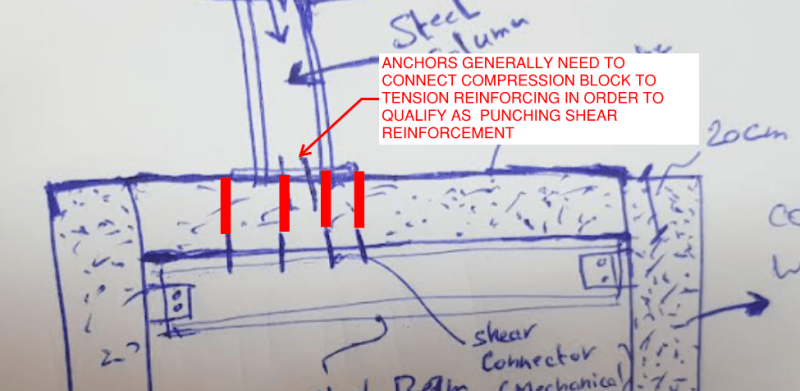tristan861
Structural
Hello guys:
I have a situation where I have to stiffen an existing slab under compression load of 370 kN (83 kips). that coming from a steel column above, Please see attached sketches.
Im trying to stiffen the slab by adding steel beam beneath it ( 3m length from wall to wall). My understanding is that the steel beam will prevent the slab from bending and will take the shear forces in case mechanical anchors are installed (composite action)?
So,
# 1 I will check the slab bearing capacity using the equation : (0.85 0.65 F'c A1), (f'c = 20 Mpa)
# 2 No need to check shear/punching shear of the slab since expansion anchors will be planted below and shear forces will be transferred to the steel beam.
# 3 Steel beam underneath to be checked for shear, bending, deflection and also flange bearing.
# 4 Mechanical anchors to be checked for shear coming from steel column.
I want to know if my approach is correct and/or if I miss something here(I'm not familiar with concrete design).
Thank you ,
I have a situation where I have to stiffen an existing slab under compression load of 370 kN (83 kips). that coming from a steel column above, Please see attached sketches.
Im trying to stiffen the slab by adding steel beam beneath it ( 3m length from wall to wall). My understanding is that the steel beam will prevent the slab from bending and will take the shear forces in case mechanical anchors are installed (composite action)?
So,
# 1 I will check the slab bearing capacity using the equation : (0.85 0.65 F'c A1), (f'c = 20 Mpa)
# 2 No need to check shear/punching shear of the slab since expansion anchors will be planted below and shear forces will be transferred to the steel beam.
# 3 Steel beam underneath to be checked for shear, bending, deflection and also flange bearing.
# 4 Mechanical anchors to be checked for shear coming from steel column.
I want to know if my approach is correct and/or if I miss something here(I'm not familiar with concrete design).
Thank you ,

